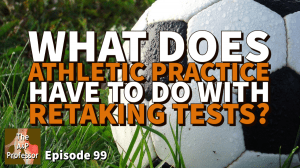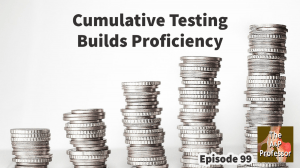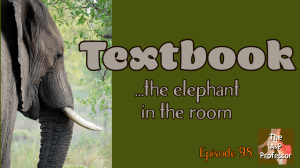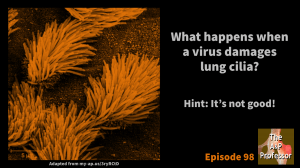In this episode, I answer a bunch of questions from Jerry Anzalone about the whacky strategies I have for testing in the A&P course. I discuss open online tests with multiple attempts, cumulative testing, pre-tests, test integrity, and much more. A virtual roundup of oddities!
0:00:00 | Introduction
0:00:54 | Quizzed About Tests
0:05:45 | Retaking Tests
0:29:37 | More on Retaking Tests
0:36:33 | Sponsored by AAA
0:38:27 | High Stakes and Low Stakes
0:46:06 | Sponsored by HAPI
0:47:30 | Open Book Tests
0:56:24 | Sponsored by HAPS
0:57:25 | Academic Integrity
1:06:17 | Final Thoughts
1:11:27 | Staying Connected
★ If you cannot see or activate the audio player, go to: theAPprofessor.org/podcast-episode-99.html
🏅 Apply for your credential (badge/certificate) for listening to this episode: theAPprofessor.org/podcast-episode-99.html/#badge
❓ Please take the anonymous survey: theAPprofessor.org/survey
☝️ Questions & Feedback: 1-833-LION-DEN (1-833-546-6336)
✔️ Follow The A&P Professor on Twitter, Facebook, Blogger, Revue, Tumblr, or Instagram! @theAPprofessor
📰 Get the almost-daily TAPP Science & Education Updates theAPprofessor.org/updates
I shall be telling this with a sigh
Somewhere ages and ages hence:
Two roads diverged in a wood, and I—
I took the one less traveled by,
And that has made all the difference. (Robert Frost)
Quizzed About Tests
5 minutes
Kevin's friend Jerry Anzalone calls in to the podcast hotline with questions about Kevin's somewhat unusual methods of online testing in the A&P course.
★ Have some follow-up questions? A completely different question? Some answers of your own?
★ Call the podcast hotline: 1.833.546.6336
Retaking Tests
24 minutes
Kevin summarizes the core ideas behind his online testing strategy: retrieval practice, spacing, interleaving, randomized question sets/pools, and more, in response to Jerry Anzalone's question...
You mentioned that you give your students the opportunity to retake the assessments as many times as necessary until they can answer the questions correctly. How exactly does that work in your courses?
★ Spaced Retrieval Practice | Episode 1
★ Revisiting Retrieval Practice | Episode 68
★ Taking Bold Steps in Teaching | Notetaking | Science Updates | TAPP 90
★ Teaching For Long Term Learning | Episode 7
More On Retaking Tests
7 minutes
The discussion continues by moving on to the topics of pre-tests and cumulative testing.
★ Pre-Testing for a Powerful Learning Boost | Episode 3
★ Cumulative Testing Makes Learning Last | Episode 4
★ Long Term Learning | Five Strategies for Teaching A&P
Sponsored by AAA
2 minutes
A searchable transcript for this episode, as well as the captioned audiogram of this episode, are sponsored by the American Association for Anatomy (AAA) at anatomy.org.
Don't forget—HAPS members get a deep discount on AAA membership!
High Stakes and Low Stakes
7.5 minutes
Kevin answers Jerry's next couple of questions...
Do unlimited retakes apply only to formative assessments such as low stakes quizzes?
How much of the overall course grade do these unlimited test opportunities make up?
★ Taking Bold Steps in Teaching | Notetaking | Science Updates | TAPP 90
Sponsored by HAPI Online Graduate Program
1.5 minute
The Master of Science in Human Anatomy & Physiology Instruction—the MS-HAPI—is a graduate program for A&P teachers, especially for those who already have a graduate/professional degree. A combination of science courses (enough to qualify you to teach at the college level) and courses in contemporary instructional practice, this program helps you be your best in both on-campus and remote teaching. Kevin Patton is a faculty member in this program at Northeast College of Health Sciences. Check it out!
Open Book Tests
9 minutes
Kevin talks hows and whys in response to this question from Jerry:
You also mentioned open-book or open-resource tests. How do you use open-book tests as assessments in your courses. For example, do your courses include one or more mid-term exams, multiple unit or module or chapter tests, frequent quizzes, and which of these, if any, are open book?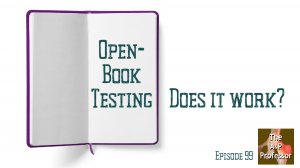
Sponsored by HAPS
1 minute
The Human Anatomy & Physiology Society (HAPS) is a sponsor of this podcast. You can help appreciate their support by clicking the link below and checking out the many resources and benefits found there. Watch for virtual town hall meetings and upcoming regional meetings!
Academic Integrity
8.5 minutes
Kevin answers Jerry's final question:
Finally, how do you try to maintain standards of academic integrity with repeat test opportunities and open book tests?
★ What the Best College Teachers Do
★ ★ Book Details: geni.us/8AoG9QY
★ ★ The A&P Professor Book Club
★ ★ Already read the book? Claim your credential
★ Promoting Academic Integrity in Our Course | Episode 25
★ The Cheater! Academic Integrity in Remote Learning | TAPP 81
★ Taking Bold Steps in Teaching | Notetaking | Science Updates | TAPP 90
Final Thoughts
5 minutes
These strategies are not the only way to do things, but may be interesting if they spark ideas among listeners.
If the hyperlinks here are not active, go to TAPPradio.org to find the episode page.
★ More details at the episode page: theAPprofessor.org/podcast-episode-99.html
★ Transcript available in the transcript box: theAPprofessor.org/podcast-episode-99.html
★ Need help accessing resources locked behind a paywall? Check out this advice from Episode 32 to get what you need! my-ap.us/paywall
Take The A&P Professor experience to the next level!
★ theAPprofessor.org/community
Earn cash by referring other A&P faculty to this podcast:
★ theAPprofessor.org/refer
Tools & Resources
★ TAPP Science & Education Updates: theAPprofessor.org/updates
★ Amazon: amzn.to/2r6Qa3J
★ Text Expander: theapprofessor.org/textexpander
★ Rev.com: try.rev.com/Cw2nZ
★ Snagit & Camtasia: techsmith.pxf.io/9MkPW
★ Krisp Free Noise-Cancelling App: theAPprofessor.org/krisp
★ JotForm (build forms for free): theAPprofessor.org/jotform
★ The A&P Professor Logo Items: https://www.teepublic.com/stores/the-a-p-professor
Sponsors
★ Transcript and captions for this episode are supported by the American Association for Anatomy | anatomy.org
★ The Human Anatomy & Physiology Society provides marketing support for this podcast | theAPprofessor.org/haps
★ Distribution of this episode is supported by the Northeast College of Health Sciences online graduate program in Human Anatomy & Physiology Instruction (HAPI) | nycc.edu/hapi
Clicking on sponsor links helps let them know you appreciate their support of this podcast!
Follow The A&P Professor on Twitter, Facebook, Blogger, Revue, Tumblr, or Instagram @theAPprofessor
The A&P Professor® and Lion Den® are registered trademarks of Lion Den Inc. (Kevin Patton)
As an Amazon Associate I earn from qualifying purchases. I may be compensated for links to sponsors and certain other links.
Click here to listen to this episode—or access the detailed notes and transcript.


